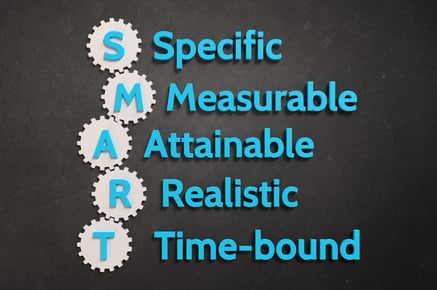Inbound Marketing Blog
for Manufacturers and Healthcare Companies
Why Is Goal Setting Important to Inbound Marketing?
What is your business striving to achieve? How do you plan for continued growth and success?
It all begins with goals.
Why is goal setting important to inbound marketing? Whether you’re planning for next year’s goals or find yourself needing to pivot on this year’s goals, goals keep you on track.
Your Top 5 Marketing Metrics
We recommend tracking these five metrics to help businesses plan their marketing goals:
- MQLs (Marketing Qualified Leads)
- SQL (Sales Qualified Leads)
- Opportunities
- Website traffic
- Site engagement
1-2) MQLs and SQLs Coming to the Site
These are good indicators of the overall health of your website and give insight as to the type of audience you’re pulling in.
3) Opportunities
Sales opportunities indicate how well your inbound strategy is moving leads through your marketing funnel. Opportunities are people who are at the bottom of your funnel and want to talk with sales about buying now.
4) Website Traffic in General
Tracking your traffic is a good first step in figuring out how wide your reach is and how well you are doing generating leads on your website. You want to grab high-quality traffic.
5) Site Engagement
Are you providing potential customers with answers to their questions? How long do they stay on your site and stay on each page? Are people coming to your site and bouncing quickly because they are confused or uninterested?
These metrics help with goal setting because they tell you where your needs are. For example, if you’re not getting enough SQLs, what goals can help you meet that need? If you’re not getting enough traffic, you’re missing out on leads. What goals can address this problem?
Time Frames to Use in Goal Setting
Goals need to be time-bound. When you’re setting goals for your marketing and sales teams, start the conversation with the big picture. This may be a time to get your C-suite in a room to throw pasta at the wall and see what sticks (we recommend fettuccine -- pre-sauce, of course).
Think Big and Then Get Small
Where would you like your company to be in five years? This may seem far off, but thinking this far ahead helps you to prioritize goals in smaller time-frames. If you want your company to pull in $X in revenue in five years, where do you need to be in three years to be on track? What does it look like to be on track in two years or one year?
Then drill down on the year ahead:
- What’s achievable this year? Take a look at last year’s results to help you get an idea of what is achievable.
- What goals can you set to improve upon last year AND get you moving toward the five-year goals?
- What needs to happen week after week, month after month, and quarter after quarter to keep you on track?
Favorite Tools To Track Goal
There are several tools to help you track goals. Some are free, which is good when you’re just starting out. Paid versions of these tools provide a lot more data and are great for more advanced online marketers.
We recommend:
- CRM (Customer Relationship Management software)
- Google tools
- Keyword research and tracking tools
CRMs
We love CRMs. It is important to manage all relationships with your customers. It’s worth investing in a CRM that does closed-loop reporting. This will greatly improve the communication between marketing and sales. In this system sales reports to marketing about what happened to the leads they received, which helps marketing understand where to find -- and not find -- quality leads.
A good CRM will also allow you to track your goals and KPIs.
Google Tools
Don’t forget about your Google tools! Make sure you properly set up tools like Google Analytics, Google Ads, and Google Search Console.
(In fact, do it now. Open a new tab and get to work! Just come back to us when you're done for more goal-setting tips!)
The Google tools are free. Make sure they are set up properly so that you get accurate data. Improper setup will give you unhelpful and incorrect data.
Keyword Tools
Use tools like SEMRush, that allow you to do keyword research as it pertains to digital marketing.
You’re Missing the Mark on Goals. Now What?
There may come a time when you realize you’re not on track to hit your goals. This isn’t the time to sweep problems under the rug. This only makes the problem worse. Focus on:
- Transparency
- Reconsidering your goals
Transparency
Transparency is key! Be honest about what has happened. Be specific about why you didn’t hit your goals. While many of us could rightfully blame some missed goals on COVID-19, this isn’t specific enough. Your best diagnosis comes from determining specifically why the goal was missed.
Reconsider Your Goals
Reconsider your goals and readjust as necessary. Get your C-suite or other stakeholders in the room and rethink your strategy. The sooner you do this, the faster and more successful you can pivot.
Best Place to Start When Setting Yearly Sales Goals
Goal setting begins with an understanding of your business objective. What do you want to accomplish this year? What milestones do you need to achieve? Work backward and think about which channels will help you achieve your goals.
Will you need to rely on tradeshow marketing? Do you need to focus more on your website to generate revenue? Figure out how many leads you will need to hit your goals, based on historic close rates. What is your average deal size and how many sales do you need to hit your goals?
Work backward from your annual goal to quarter by quarter and month by month goals and set up KPIs to monitor over these time periods.
Concerns For Sales Teams
The COVID-19 pandemic has changed the business world in long-lasting ways. The tradeshow world, which is a great B2B lead generator, will most likely never go back to the way it used to be. Virtual versions have made it so people don’t have to travel across the country to discover new business opportunities.
Sales teams don’t have to travel, either. A lot of work can be done remotely. Remote work brings with it opportunities -- like cutting down on travel time and costs -- and challenges -- making sure your team is set up to properly communicate internally and externally.

Set SMART Goals
Your goals need to be SMART -- specific, measurable, achievable, relevant, and time-bound). You may want to bring in your managers, executives, or teammates to get advice on how to make your goals SMART.
Prioritizing Goals -- Where to Start?
Perhaps this is a good time to bring your C-suite in for more pasta chucking. Consider your achievable goals (like growing 30 percent by next year) and your BHAGs (your WHAT? Big, hairy audacious goals - like growing the company 170 percent in a year).
Look at all your goals and think about how achievable the goal is and what impact a goal would have on your company is achieved. Use these considerations to prioritize your goals.
Goal-Setting Process
- Get your sales manager and sales staff in a room to review the previous year’s revenue and consider what may happen in the market this year.
- Review what actions pulled in leads. Since these actions cost money, what was the ROI?
- Consider what you can do to keep current leads and attract quality leads.
- Use a CRM. If it isn’t in the CRM, it didn’t happen.
Measuring Success of Goals
- Use tracking tools! Shop around and find out what tools suit your needs.
- Discover how leads found your site, which pages they visited, what forms they filled out, what keywords they used. Are these metrics aligned with your goals?
- Consider working with an agency to manage Google Ads. Partner with them to build a better SEO strategy.
- Use lead scoring to evaluate your leads and ensure your automated follow-ups are sent to the right leads.
- Qualify your leads. Don’t send leads to sales until you know they are ready.
Staying On Top of Goals
- Review goals on a quarterly basis. Are you hitting the target or do you need to pivot? For example, if your marketing strategy is focused more on print media but the leads aren’t coming in, maybe it’s time to reconsider the strategy and pivot toward a digital marketing strategy.
- Also, ask your sales team about how they think your strategy is performing. Since they work to close on leads, they have insight into the quality of leads coming in. They may have some suggestions about lead generation.
- Consider contingencies to your marketing spend. For example, a pandemic stops plans for tradeshows for Q1, then Q2, and Q3. Where do you reallocate your marketing budget to help you achieve your goals?
Work With All Of Your Teams
So, what do you do now? Work with all of your teams -- not in a silo -- to set realistic goals and then break them down into shorter SMART goals. Also, know that you may not always achieve your goals. Be agile and pivot when needed.
Make sure your communication is stellar across teams. Don’t take for granted that each team understands what the others are doing. Goals can’t be achieved unless everyone is on the same page. Align marketing and sales, communicate openly, and help each other reach goals!
Need Help Setting SMART Goals?
SMART goals aren’t easy to set. We have a workbook that can help you through the process:
Want a Deeper Dive?
For a deeper dive into the topic, watch the video version of this article above. Josh Curcio, COO and partner at protocol 80 (and self-proclaimed HubSpot expert), and Holly McCully, inbound marketing consultant at p80 (and niche inbound strategy expert), talk goal setting, tracking, and the importance of being agile.
Josh and Holly bring in Kevin Must, Global Inbound Marketing Manager, with Lantek to give his goal-setting advice.
Our Blogs, Direct to Your Inbox!
How to Audit your Online Marketing
If you are executing digital marketing, congratulations! You are most likely already one step ahead of your competition, and making strides to meaningfully connect with prospects online. But, how do you know if you’re seeing continual success year over year, and improving your metrics?
Without the tools in place to analyze and benchmark your efforts, it is impossible to scale your online marketing and ensure continuous success.


